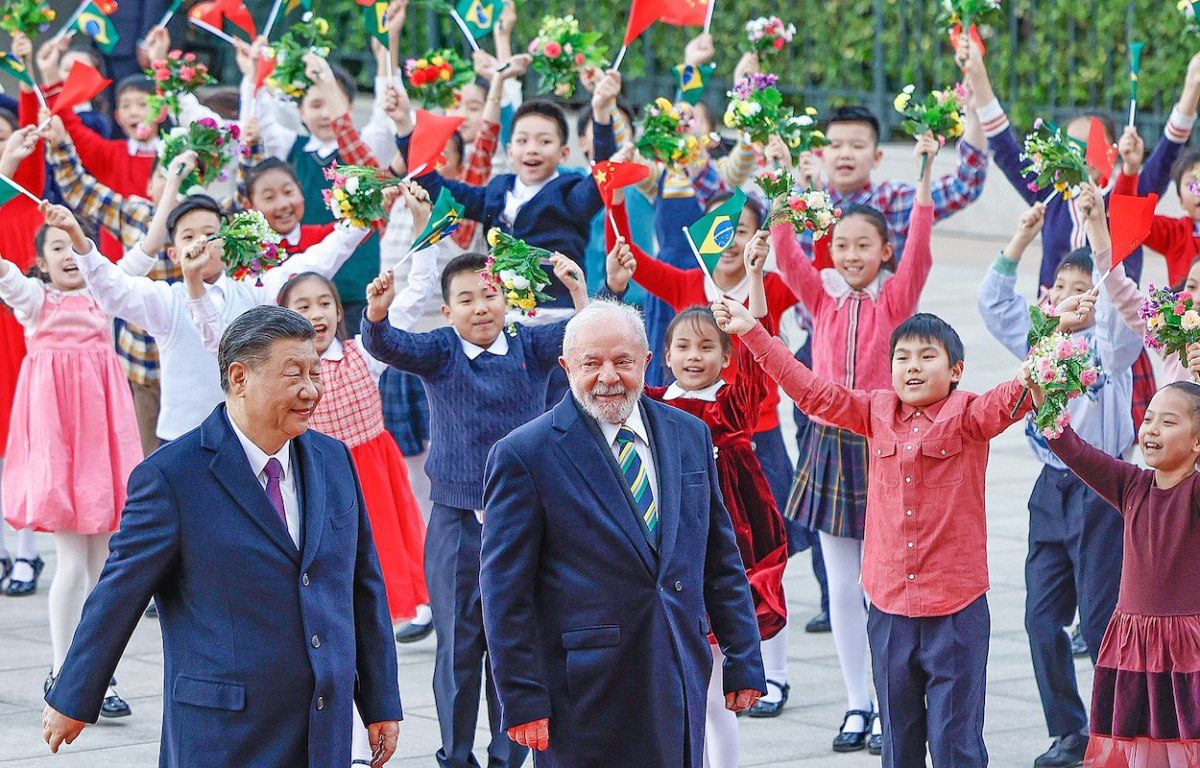Global Courant 2023-04-17 11:43:04
For Xi Jinping, last week was easily one of the best the Chinese leader has had in a long time.
First, French President Emmanuel Macron dropped by to talk about the merits of Europe blazing a diplomatic path independent of the US. For the record, Macron gave Beijing the impression that Paris is not keen on defending Taiwan should a conflict break out.
Then it was Brazilian President Luiz Inacio Lula da Silva’s turn to make global headlines at Washington’s expense. Lula visited Huawei Technologies, a target of US sanctions. He also entertained Xi’s ceasefire in Ukraine, a ceasefire that Washington has flatly rejected.
But the real tailwind that brought Lula to the city has to do with Xi’s long-held desire to reduce the role of the US dollar.
During a visit to Shanghai, Lula urged the other BRICS economies – Brazil, Russia, India, China and South Africa – to step up their efforts to displace the dollar in world trade and finance. He said the BRICS-created New Development Bank should take the lead in fighting away Washington’s financial power.
“Why can’t an institution like the BRICS bank have currency to finance trade relations between Brazil and China, between Brazil and all the other BRICS countries?” Lula asked. “Who decided that the dollar was the (trade) currency after the end of gold parity?”
It sounded like music to Xi’s ears. Reducing the dollar’s dominance in world trade has been a top goal since 2012, when Xi first took power. Since then, China has made steady progress toward increasing the use of the yuan in transactions, payments and bond issues, including Russian and Saudi Arabian oil sales.
Last month, Beijing and Brasilia tightened their cooperation in handling foreign trade in yuan or Brazilian reais. In addition, the largest economies in Asia and Latin America will significantly reduce costs by eliminating a third currency.
In Shanghai, Fernando Haddad, Lula’s finance minister, highlighted the increased use of local currency in bilateral trade tools such as credit receipts. The focus now, Haddad said, is on phasing out the use of a third currency through new trading mechanisms and media.
“The advantage is to avoid the straitjacket imposed by necessarily having trade transactions settled in a currency of a country not involved in the transaction,” he told reporters.
Lula’s boost to Xi’s “Global South” ambitions should not be downplayed. In his third term, Xi puts more emphasis on transforming the Global South, or developing countries in regions from Latin America to Africa to Asia to Oceania, into greater economic and diplomatic power.
For Xi, rising tensions with the West – the Global North – mean that “trade diversification is a critical part of this effort,” says analyst Lily McElwee of the Center for Strategic and International Studies (CSIS).
The visit of Brazil’s leader bore other fruits. Lula agreed with the terms favored by both Moscow and Beijing that negotiations on Ukraine are “the only viable way out of the crisis”, while avoiding the words “invasion” or “war”.
Backfire on Washington
But the really viable way is for the leader of the Latin American superpower to turn his nose at US President Joe Biden’s economy — and at a pivotal moment when Washington turns Beijing’s screws on trade and access to vital technology.
The Brazilian president met with Biden in February. As such, “Lula’s interest in closer relations with China is not indicative of diminished interest in relations with the US and Western allies, but it brings greater complexities,” said Eurasia Group analyst Anna Ashton.
Here, however, Lula’s support for an alternative to the dollar could be a particularly powerful driver for Xi. Even former Goldman Sachs economist Jim O’Neill, who coined the original BRIC acronym in 2001, thinks the dollar’s influence has gotten too big for Washington’s pants.
“The US dollar is playing a far too dominant role in global finance,” says O’Neill. “Whenever the Federal Reserve Board has entered periods of monetary tightening, or easing, the impact on dollar values and knock-on effects has been dramatic.”
Eight years after O’Neill’s BRIC concept caught the attention of developing countries, Brazil, Russia, India and China decided to institutionalize the grouping. In 2009, the BRIC infrastructure was established, including holding annual summits. In 2010, the bloc added South Africa to become the BRICS.
Today, O’Neill argues that broadening the BRICS base to include other “emerging countries with persistent surpluses” could create a “fairer global multi-currency system” to even out economic power dynamics.
Hence the power – and the timing – of Lula’s buy-in. During his earlier stint as Brazilian leader, Lula attended that first BRIC summit in Yekaterinburg, Russia. That was when Xi’s predecessor Hu Jintao led the Communist Party of China (CPC).
The 2009 summit came during the financial fallout from the Wall Street implosion nine months earlier. In Yekaterinburg, the BRIC countries discussed how officials in Beijing, Brasilia, Moscow and New Delhi could better collaborate on economic and shared priorities in global affairs.
There, leaders agreed on the need for a new global reserve currency that offers “diverse, stable and predictable” qualities that the dollar has been declining to display.
That statement briefly sent the dollar lower against major currencies. At the time, then-Russian President Dmitry Medvedev said that “the BRIC summit (process) must create the conditions for a fairer world order.”
In Yekaterinburg, Medvedev said 14 years ago that the “existing set of reserve currencies, including the US dollar, have failed to fulfill their function. We cannot do without additional reserve currencies.”
He spoke of a new supranational reserve currency at a time when the International Monetary Fund’s “special drawing rights” (SDR) program was taking on a larger role in financial circles.
In the weeks leading up to Yekaterinburg, Moscow called for an expansion of the SDR universe, one China to join in 2016. In 2009, Roberto Mangabeira Unger, Brazil’s then Minister of Strategic Affairs, said, “Everyone is concerned about the delicacy of this issue. No one wants to say or do things that would increase volatility during the crisis.”
Shifting centers of power
Since then a lot has changed. Lula has regained power from Jair Bolsonaro’s chaotic and isolationist reign. Vladimir Putin has officially regained control of the Russian state and is more anti-Western than ever.
The reign of Hindu nationalist Narendra Modi in India has seen New Delhi crawl to Moscow for cheap oil. And Xi, after ten years in power, now puts expanding China’s international role at the top of his list of priorities.
CSIS’s McElwee notes that “in this push, enhanced trade with Russia is helpful” as Putin “increasingly relies on China for advanced technology that now has a very limited capacity to buy officially from Western countries, such as semiconductors and telecommunications equipment, even while it remains only part of a longer-term Chinese export diversification that also includes many countries in the South.”
Similarly, McElwee explains, “As China’s international environment sours, Beijing increasingly seeks to increase self-sufficiency in nuclear technologies. For example, just weeks ago, policymakers in Beijing signaled the centrality of this priority by launching a new CPC commission designed to enhance China’s research and innovation capabilities.”
This “goal could be a boost to Moscow’s pariah status,” says McElwee. “While better access to Russia’s top science faculties and research and development facilities has long been a goal, recent joint ventures suggest that Beijing is using its close collaboration with Moscow to improve the quality of China’s science and technology education ecosystem.”
As Xi increases the independence of China’s supply chains from Biden’s sanctions, Lula’s return to Brazilian power gives impetus to Beijing’s larger ambitions to replace the dollar.
More cooperation proved difficult during Bolsonaro’s presidency from 2019-2022, during which right-wing politicians accused Chinese companies of “buying” Brazil. Now Lula, who returned to his post in January, is working on at least 20 bilateral projects with Beijing in areas from agriculture to the environment to education to technology and countless business deals.
One of the business stories Lula played last week is Chinese manufacturer BYD’s plans to take over a former Ford plant in northeastern Brazil. In October, BYD signed a letter of intent with the Bahia state government to invest more than $600 million in electric vehicle production, creating approximately 1,200 jobs.
Coming up with the logistics and mechanics of a BRICS currency is infinitely easier said than done. China, which is even hesitant to make the yuan fully convertible, is it ready to join a giant currency bloc?
Of course, the near-term outlook for the dollar is being jeopardized by recession fears, which have only been exacerbated by the collapse of Silicon Valley Bank and peers.
“We expect the US dollar to weaken as US growth and the interest rate premium relative to the rest of the world erode in the coming months,” said Solita Marcelli, Americas chief investment officer at UBS Global Wealth Management.
However, the dollar has much bigger problems. They include the US Federal Reserve unnerving global markets with aggressive rate hikes, Washington’s debt rising to $32 trillion, and concerns that the Biden White House is overplaying its hand with sanctions against China and Russia.
And now Brazil’s Lula is helping Xi’s quest to increase the influence of the Global South and remind traders that time is not on the dollar’s side.
A great week indeed for Xi’s broader ambitions.
Similar:
Loading…








